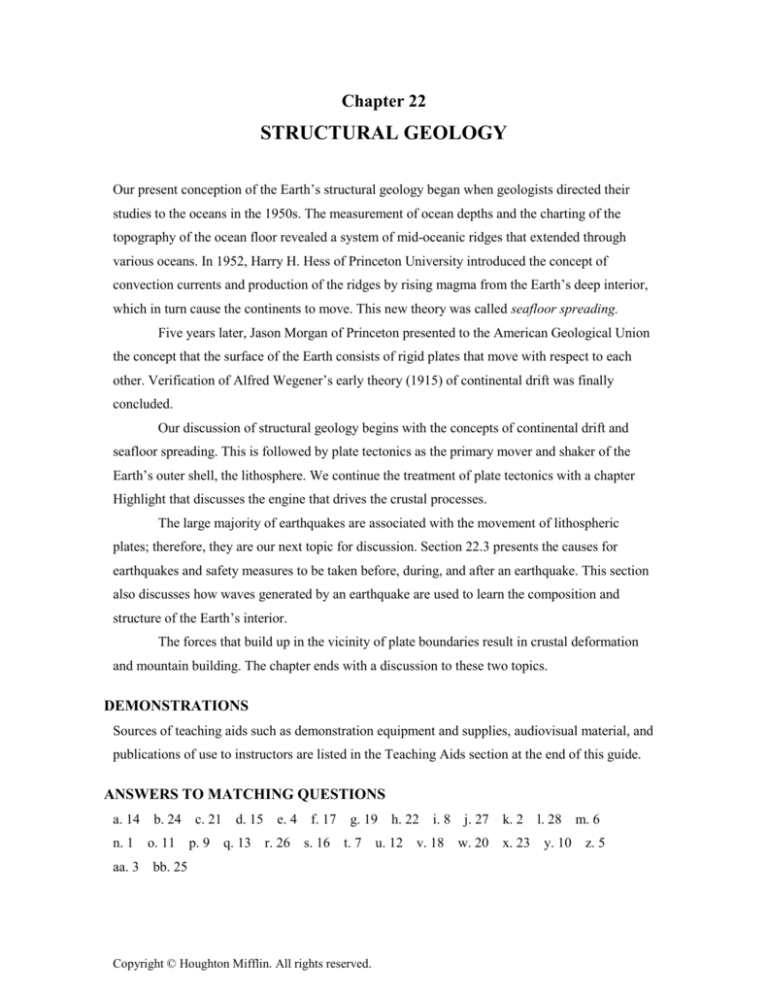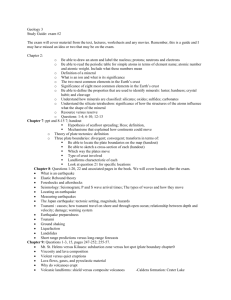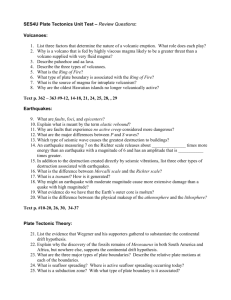
Chapter 22
STRUCTURAL GEOLOGY
Our present conception of the Earth’s structural geology began when geologists directed their
studies to the oceans in the 1950s. The measurement of ocean depths and the charting of the
topography of the ocean floor revealed a system of mid-oceanic ridges that extended through
various oceans. In 1952, Harry H. Hess of Princeton University introduced the concept of
convection currents and production of the ridges by rising magma from the Earth’s deep interior,
which in turn cause the continents to move. This new theory was called seafloor spreading.
Five years later, Jason Morgan of Princeton presented to the American Geological Union
the concept that the surface of the Earth consists of rigid plates that move with respect to each
other. Verification of Alfred Wegener’s early theory (1915) of continental drift was finally
concluded.
Our discussion of structural geology begins with the concepts of continental drift and
seafloor spreading. This is followed by plate tectonics as the primary mover and shaker of the
Earth’s outer shell, the lithosphere. We continue the treatment of plate tectonics with a chapter
Highlight that discusses the engine that drives the crustal processes.
The large majority of earthquakes are associated with the movement of lithospheric
plates; therefore, they are our next topic for discussion. Section 22.3 presents the causes for
earthquakes and safety measures to be taken before, during, and after an earthquake. This section
also discusses how waves generated by an earthquake are used to learn the composition and
structure of the Earth’s interior.
The forces that build up in the vicinity of plate boundaries result in crustal deformation
and mountain building. The chapter ends with a discussion to these two topics.
DEMONSTRATIONS
Sources of teaching aids such as demonstration equipment and supplies, audiovisual material, and
publications of use to instructors are listed in the Teaching Aids section at the end of this guide.
ANSWERS TO MATCHING QUESTIONS
a. 14
b. 24 c. 21 d. 15 e. 4 f. 17
g. 19 h. 22 i. 8 j. 27
n. 1 o. 11 p. 9 q. 13 r. 26 s. 16 t. 7 u. 12 v. 18
aa. 3
bb. 25
Copyright © Houghton Mifflin. All rights reserved.
w. 20
k. 2
l. 28 m. 6
x. 23 y. 10
z. 5
ANSWERS TO MULTIPLE-CHOICE QUESTIONS
1. d 2. b 3. a 4. d 5. c
6. a 7. b 8. b
9. c 10. d 11. a
12. c
ANSWERS TO FILL-IN-THE-BLANK QUESTIONS
1. continental drift 2. magnestism 3. mid-ocean
6. transform 7. Moho
4. asthenosphere
8. outer core 9. S 10. synclines
5. Convection
11. volcanic 12. reverse
ANSWERS TO SHORT-ANSWER QUESTIONS
1. In the theory of plate tectonics, Pangaea is the supercontinent that broke apart about 200
million years ago.
2. Remanent magnetism refers to the magnetism of rocks resulting from a special group of
minerals called ferrites.
3. Continuity of geologic features, biological evidence, glacial evidence.
4. The Mid-Atlantic Ridge is a ridge that runs along the center of the Atlantic Ocean between the
continents.
5. A huge slab of lithosphere material.
6. The lithosphere is the solid outer shell of the Earth; it includes the crust and some of the upper
mantle. The asthenosphere is the region below the lithosphere that is hot enough to be easily
deformed and is capable of internal flow.
7. The concept that the Earth’s crustal material “floats” in gravitational equilibrium on a “fluid”
substratum.
8. Divergent (new rock is formed); convergent (rock is consumed); transform (rock is neither
produced nor consumed). See A Spotlight on Plate Boundaries.
9. The region where one plate is deflected downward and beneath another plate.
10. Convergent; divergent; transform.
11. The oceanic plate is subducted. Oceanic crust has a higher density (3.0 g/cm3) than does
continental crust (2.7 g/cm3).
12. 6400 km, 4000 miles.
13. Crust, mantle, outer core, inner core.
14. 19 to 40 km under the continents; 5 to 11 km under the ocean basins.
15. The Moho is the boundary between the crust and the mantle.
2
16. Both volcanoes and earthquakes are produced primarily at plate boundaries because of the
stresses caused as plates shift.
17. The Pacific plate is moving northward relative to the North American plate.
18. The focus of an earthquake is the point or region of the initial energy release or slippage. The
epicenter is the location on Earth’s surface directly above the focus.
19. S waves.
20. (a) The Richter scale gives an absolute measure of the energy released by calculating the
energy of seismic waves at a standard distance.
(b) The Mercalli scale describes the severity of an earthquake by its observed effects.
21. The magnitude 6.0 quake releases about 31 times more energy.
22. Quake magnitude, location of the focus and epicenter, and environment of the region around
the epicenter.
23. A tidal wave has nothing to do with tides. The correct term is tsunami.
24. An anticline is a rock fold with downward sloping on both sides of a common crest. A syncline
is a rock fold with upward sloping on both sides of a common trough.
25. (a) Normal fault: occurs as the result of expansive forces that cause its overlying side to move
downward relative to the side beneath it.
(b) Reverse fault: occurs as the result of compressional forces that cause the overlying side of
the fault to move upward relative to the side beneath it.
(c) Transform, or strike-slip fault: occurs when the stresses are parallel to the fault boundary
such that the fault slip is horizontal.
26. The convergent boundary.
27. (a) Fault-block.
(b) Fold. (c) Volcanic. (d) Fold.
28. Indian plate and Eurasian plate.
ANSWERS TO APPLYING-YOUR-KNOWLEDGE QUESTIONS
1. Both use the process of investigation to obtain and identify clues to discover the unknown. The
geologist investigates for clues to understand the Earth’s past and present. The detective
investigates for clues to solve a crime.
2. If you live in North America, the North American plate.
3. Individual answers will differ.
3
4. In both events more material is being forced into an area too small to occupy. The area folds or
buckles in response to the material being forced in.
5. According to FEMA (Table 22.2), persons inside should take shelter inside. Persons outside
should move to open spaces. Neither of you picked the right course of action, according to
FEMA.
6. The collision of the Indian plate with the Eurasian plate raised material from a former seafloor
to make part of the Himalayas.
7. You are correct. It is best to ride the ocean wave on open water and avoid the shoreline.
ANSWERS TO VISUAL CONNECTION
a. middle layer
4
b. mantle c. core d. outer (core)









